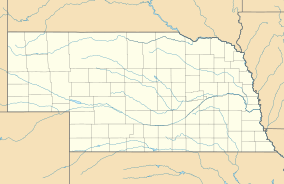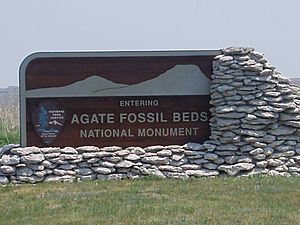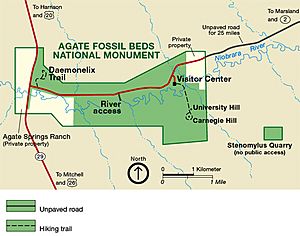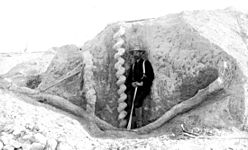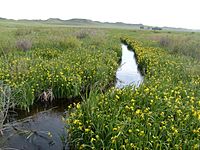Agate Fossil Beds National Monument facts for kids
Quick facts for kids Agate Fossil Beds National Monument |
|
|---|---|
|
IUCN Category III (Natural Monument)
|
|
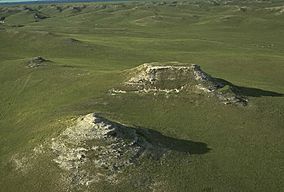
University and Carnegie Hills fossil beds
|
|
| Location | Sioux County, Nebraska, United States |
| Nearest city | Harrison, NE |
| Area | 3,057.87 acres (12.3748 km2) |
| Established | June 14, 1997 |
| Visitors | 15,555 (in 2016) |
| Governing body | National Park Service |
| Website | Agate Fossil Beds National Monument |
Agate Fossil Beds National Monument is a special place in Nebraska, United States. It's a U.S. National Monument because of the amazing fossils found there. The monument is near the town of Harrison, Nebraska.
The main parts of this monument are a valley carved by the Niobrara River. You'll also find two hills, Carnegie Hill and University Hill, where many fossils have been discovered. The area is mostly grass-covered plains. You can see plants like prairie sandreed, blue grama, and little bluestem. Wildflowers like lupin, spiderwort, and sunflowers also grow here.
Discovering Ancient Life
Agate Fossil Beds is famous for its many well-preserved Miocene fossils. These fossils are like clues from Earth's past. They tell us about animals that lived here millions of years ago. Most of these incredible fossils were found at dig sites on Carnegie and University Hills.
The fossils found here are from about 20 to 16.3 million years ago. This time period is called the Miocene epoch. The fossils are some of the best examples of mammals from that time.
Amazing Ancient Animals
Scientists have found many different kinds of ancient animals at Agate. Imagine these creatures roaming the plains of Nebraska long ago! Here are some of the cool animals discovered:
- Miohippus: This was an early ancestor of the modern horse. It was much smaller than horses today.
- Menoceras: A rhinoceros about the size of a pony. It had two horns side-by-side on its nose.
- Daphoenodon: This animal was a "bear dog." It looked a bit like a bear but was related to dogs.
- Daeodon: The largest of the Entelodonts. These were giant pig-like animals with huge heads.
- Stenomylus: A small, gazelle-like camelid. It was an early relative of camels.
- Palaeocastor: These were land beavers. They dug very unique, corkscrew-shaped burrows called Daemonelix.
- Moropus: A strange animal called a chalicothere. These were relatives of rhinos and horses, but they had claws instead of hooves.
History of the Monument
The land where Agate Fossil Beds National Monument now stands was once a working cattle ranch. It was owned by a man named Captain James Cook. His family played a big part in discovering and protecting these fossils.
The monument's museum also has a special collection. It contains over 500 items from the Cook family. These items are artifacts from Plains Indians, showing their history and culture.
The idea to make this area a national monument started a long time ago. It was officially allowed on June 5, 1965. However, it wasn't fully established as a national monument until June 14, 1997. The place where Harold J. Cook lived, known as the Bone Cabin Complex, was added to the National Register of Historic Places in 1977. The National Park Service takes care of Agate Fossil Beds today. They help protect the fossils and teach visitors about this amazing place.
Gallery
|
See also
 In Spanish: Monumento nacional de Yacimientos de Fósiles de Ágata para niños
In Spanish: Monumento nacional de Yacimientos de Fósiles de Ágata para niños


